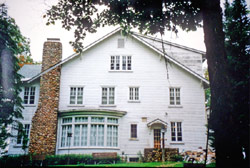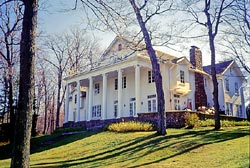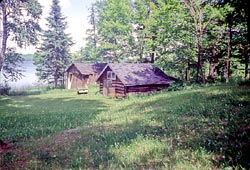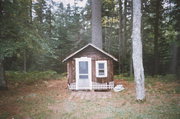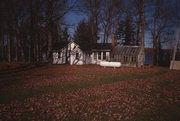934 Fort Eagle Ln.
| Historic Name: | Fort Eagle |
|---|---|
| Reference Number: | 98001090 |
| Location (Address): | 934 Fort Eagle Ln. |
|---|---|
| County: | Vilas |
| City/Village: | |
| Township: | Phelps |
| Fort Eagle 934 Fort Eagle Lane Town of Phelps, Vilas County Date of Construction: 1919 to 1927 The beautiful buildings that make up Fort Eagle hide a more sordid tale of "Homeless Homer," a Chicago politician on the run from the law. The complex, which includes a main house, gazebo, wet boathouse, "honeymoon cottage," caretaker's cottage with attached greenhouse, six car garage, and other buildings, served as a vacation home for Homer Galpin, head of the Republican party in Chicago, and his wife from 1916 to 1941. The life of Fort Eagle's flamboyant first owner is just as interesting as the complex's impressive architecture. Galpin was a leading figure in Chicago politics, during a time when the Republican "machine" dominated the city. He managed Chicago Mayor William "Big Bull" Thompson's 1928 campaign funds, which authorities believed came primarily from gamblers and bootleggers. After the election, Galpin was subpoenaed to testify before a grand jury about the relationship between organized crime and the corrupt funds he managed. Because he evaded subpoena by hiding at Fort Eagle and in Florida, he earned the nickname "Homeless Homer." Galpin never faced a grand jury. Despite his questionable politics, Galpin worked hard to promote Northwoods tourism. He used his connections to bring sleeping car rail service to Phelps and encouraged wealthy Chicagoans, including Mayor William Thompson and, allegedly, gangster leader Al Capone to vacation in Northern Wisconsin. As long-time president of Eagle River Fishing and Shooting Club, later renamed the Big Sand Lake Club, he actively supported recreational tourism. Before Galpin built his elaborate summer estate, he constructed a log cottage in 1919 on a 700-acre plot along the south shore of Big Sand Lake where he and his wife Hilda vacationed. In 1927, he transformed his tiny cottage into a large manse and constructed 16 other support buildings. The 2.5 story 9,000 square foot main house completely enveloped his cottage. It has narrow clapboard siding painted white, a roof covered with variegated green asphalt shingles, three massive chimneys, French doors, casement windows and exposed rafters. The Colonial Revival main house, loosely based on Southern colonial architecture, was the height of suburban taste at that time, but stands at odds to the Rustic Style log architecture most prevalent in northern Wisconsin. Fort Eagle is a private residence, but is visible from the waters of Big Sand Lake. Please respect the privacy rights of its owner.
|
| Period of Significance: | 1900-1924 |
|---|---|
| Period of Significance: | 1925-1949 |
| Area of Significance: | Architecture |
| Area of Significance: | Entertainment/Recreation |
| Area of Significance: | Social History |
| Applicable Criteria: | Architecture/Engineering |
| Applicable Criteria: | Person |
| Historic Use: | Domestic: Single Dwelling |
| Historic Use: | Domestic: Secondary Structure |
| Architectural Style: | Bungalow/Craftsman |
| Architectural Style: | Colonial Revival |
| Resource Type: | Building |
| Historic Status: | Listed in the National Register |
|---|---|
| Historic Status: | Listed in the State Register |
| National Register Listing Date: | 08/20/1998 |
| State Register Listing Date: | 07/20/1998 |
| Number of Contributing Buildings: | 14 |
|---|---|
| Number of Contributing Sites: | 0 |
| Number of Contributing Structures: | 0 |
| Number of Contributing Objects: | 0 |
| Number of Non-Contributing Sites: | 0 |
| Number of Non-Contributing Structures: | 0 |
| Number of Non-Contributing Objects: | 0 |
| National Register and State Register of Historic Places, State Historic Preservation Office, Wisconsin Historical Society, Madison, Wisconsin |

